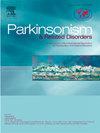Clinical progression of Parkinson's disease in the early 21st century: Insights from the accelerating medicine partnership (AMP-PD) data
IF 3.1
3区 医学
Q2 CLINICAL NEUROLOGY
引用次数: 0
Abstract
Background
Parkinson's disease (PD) therapeutic strategies have evolved since levodopa introduction in mid 1900s. To understand their impact and research gaps, this study delineated the clinical progression of PD in recent years.
Methods
Using Accelerating Medicine Partnership-PD (AMP-PD) data harmonized from seven biomarker discovery studies (2010–2020), we extracted: overall [Schwab and England (S&E), PD Questionnaire (PDQ-39)]; motor [Movement Disorders Society Unified PD Rating Scale (MDS-UPDRS)-II and -III and Hoehn & Yahr (HY)]; and non-motor [MDS-UPDRS-I, University of Pennsylvania Smell Identification Test (UPSIT), Montreal Cognitive Assessment (MoCA), and Epworth Sleepiness Scale (ESS)] scores. Age at diagnosis was set as 0 years, and data were tracked for 15 subsequent years.
Results
Among 3001 PD cases identified to be suitable for this study, 2838 are white, 1843 are males, with a mean age at diagnosis was 60.2 ± 10.3 years. At baseline evaluation, the disease duration was 9.9 ± 6.0 years overall, 1915 within 0–5, 541 with 6–10, 254 within 11–15, and 163 greater than 15 years. Participants largely reported independence (S&E, 5y: 86.6 ± 12.3; 10y: 78.9 ± 19.3; 15y: 78.5 ± 17.0) and good quality of life (PDQ-39, 5y: 15.5 ± 12.3; 10y: 22.1 ± 15.8; 15y: 24.3 ± 14.4). Motor scores displayed a linear progression, whereas non-motor scores plateaued ∼10–15 years. Younger onset age and female correlated with slower progression.
Conclusions
Twenty-first century PD patients remain largely independent in the first decade of disease at tertiary subspecialty care and research centers. There are data gaps for those who are non-whites or longer PD duration, and sensible metrics that can gauge non-motor progression when PD is beyond 10 years.
21 世纪初帕金森病的临床进展:从加速医学伙伴关系(AMP-PD)数据中获得的启示。
背景:自20世纪中期左旋多巴问世以来,帕金森病(PD)的治疗策略不断发展。为了解其影响和研究空白,本研究对近年来帕金森病的临床进展进行了划分:利用从七项生物标记物发现研究(2010-2020 年)中协调的加速医学合作--帕金森病(AMP-PD)数据,我们提取了帕金森病的总体[施瓦布和英格兰(Schwab and England, AMP-PD)]数据:总体[Schwab and England (S&E)、PD Questionnaire (PDQ-39)];运动[运动障碍协会统一PD评定量表(MDS-UPDRS)-II和-III以及Hoehn & Yahr (HY)];非运动[MDS-UPDRS-I、宾夕法尼亚大学嗅觉识别测试(UPSIT)、蒙特利尔认知评估(MoCA)以及Epworth嗜睡量表(ESS)]得分。诊断时的年龄设定为 0 岁,并对随后 15 年的数据进行跟踪:在3001例适合本研究的帕金森病患者中,2838例为白人,1843例为男性,诊断时的平均年龄为(60.2 ± 10.3)岁。在基线评估中,总体病程为(9.9 ± 6.0)年,0-5年1915年,6-10年541年,11-15年254年,15年以上163年。大部分患者表示能够独立生活(S&E,5 年:86.6 ± 12.3;10 年:78.9 ± 19.3;15 年:78.5 ± 17.0),生活质量良好(PDQ-39,5 年:15.5 ± 12.3;10 年:22.1 ± 15.8;15 年:24.3 ± 14.4)。运动评分呈线性增长,而非运动评分则在 10-15 年间趋于稳定。发病年龄越小、女性越多,病情进展越慢:结论:二十一世纪的帕金森病患者在三级亚专科护理和研究中心发病的前十年基本保持独立。对于非白种人或病程较长的帕金森病患者来说,还存在数据缺口。
本文章由计算机程序翻译,如有差异,请以英文原文为准。
求助全文
约1分钟内获得全文
求助全文
来源期刊

Parkinsonism & related disorders
医学-临床神经学
CiteScore
6.20
自引率
4.90%
发文量
292
审稿时长
39 days
期刊介绍:
Parkinsonism & Related Disorders publishes the results of basic and clinical research contributing to the understanding, diagnosis and treatment of all neurodegenerative syndromes in which Parkinsonism, Essential Tremor or related movement disorders may be a feature. Regular features will include: Review Articles, Point of View articles, Full-length Articles, Short Communications, Case Reports and Letter to the Editor.
 求助内容:
求助内容: 应助结果提醒方式:
应助结果提醒方式:


